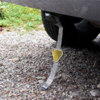- Joined
- 27 Jan 2008
- Messages
- 27,740
- Reaction score
- 3,364
- Location
- Llanfair Caereinion, Nr Welshpool
- Country

 In the old days of cross ply tyres we would often see vehicle earths, however most tyres today like wellingtons have graphite in the mix, so do connect to ground. Hence why wearing rubber boots does not stop you getting a shock.
In the old days of cross ply tyres we would often see vehicle earths, however most tyres today like wellingtons have graphite in the mix, so do connect to ground. Hence why wearing rubber boots does not stop you getting a shock.The idea is to get rid of static rather than electricity made by design. But clearly they are likely earthed.
The whole problem with TN-C-S when charging an EV is the body of the car becoming a different voltage to the ground. Why it is not isolated not a clue, my EV an e-bike uses a fig of 8 the IEC 60320 C7 and C8 so no earth connected to charger or e-bike, why cars need an earth not sure, electric vehicles have had connectors like this
But the whole point with electric cars is we don't know. I assumed all EV cars could charge at 22 kW with a three phase supply but this
 from a video
from a video We have also looked at this

This does present a problem when doing an EICR. Installation it seems includes lights, but no other current using equipment, but the charger does not use current it only passes it to the vehicle so is part of the fixed installation if screwed to the wall.
There is a little uncertainty with plug in, this
 may supply an EV charger, could supply a welder or any other appliance so is not considered as an EV charging point.
may supply an EV charger, could supply a welder or any other appliance so is not considered as an EV charging point. So as electricians we are left with very little general information, we can look up details of one car, but we have no idea if all cars are the same.
So be it feed in or out of the car, it may be safe with one car, and dangerous with another, it may even be a fault and the car body may be intended to be isolated, but a fault can caused it not to be.
There is so much miss information, not a clue what bits of my car are plastic and what is steel unless I see rust, but there was rust on the Supervan II used in only fools and horses even when made of fibre glass.
So what we are looking at is if we have a 16 amp plug and socket supplying critical equipment in the home, i.e. freezer, lights and central heating so we can unplug from mains and plug into a generator when we have a power failure what happens with the earth?
And it really does not matter if the generator is powered from battery or engine we are looking at the same thing, what happens with the earth.
The danger as I see it is were two earthing systems are joined. I have only once seen one of these

Without such a device there is a problem with over current in earth cables.Neutral Earthing resistor systems protect power transformers and generators from damaging fault currents. Earthing of the neutral limits the ground fault current to a high level (typically 50 amps or more) in order to operate protective fault clearing relays and current transformers. These devices are then able to quickly clear the fault, usually within a few seconds.
The running of a small induction hob at a picnic spot is not really a problem, it is in the home and the problems with two independent earthing systems.
If I run a supply to my freezer from a generator the only safe method is for whole house to be TT.
So back to should TN-C-S be outlawed?
